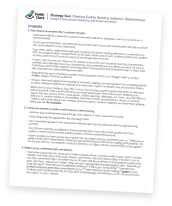Strategy: Charting Tool for Building Authentic Relationships
Check-Up Menu > Charting Tool for Building Authentic Relationships
Use this strategy to improve these areas:
Overview
Building authentic relationships with students and families requires a specific, measurable, realistic, and timely plan. This strategy provides you with an extensive menu of relationship-building activities to review. You will then use a charting tool to identify cultural characteristics about your students and to choose a specific relationship-building activity that you can implement with each student and their family.
Purpose
This strategy provides you with a multitude of relationship-building activities that can be used with students and families. It is important to remember that there is not a one-size-fits-all approach to building authentic relationships and the menu of options provided allows you to tailor your efforts to the individual student and/or family. After using this strategy, you will have a clear plan for how to deepen authentic relationships with your students.
How the Authentic Relationships Charting Tool Connects to CARES
Authentic relationships do not just happen. Educators need to be intentional in the strategies they use to deepen relationships with students and families. Spending the time to reflect on each student’s cultural background and choosing a specific relationship-building activity to use with each student lays the groundwork for deepening and maintaining authentic relationships with students. Using this strategy will help you to get to know more about your students both personally and academically, which will show them that you care about them and will result in greater connection to your classroom, more positive teacher-student interactions, and fewer behavioral concerns.
Some key elements for effectively using the charting tool:
1) There are many different ways to build authentic relationships. Review the strategies that we have provided and also reflect on strategies that you may have used in the past that either worked well or did not work at all. Our list is not exhaustive and you are welcome to use other strategies, but we invite you to try at least three strategies that are new to you.
2) Be honest with yourself as you complete the charting tool. If you realize that you do not know much or anything about one of your students, do not beat yourself up. Reflect on why that might be and set a goal to use at least one strategy to get to know that student better sooner rather than later.
How To
How to Use the Charting Tool for Building Authentic Relationships with Students and Families
1) Review the “Strategies to Build Authentic Relationships for Students and Families” document.
Fill out the charting tool for each student or for a select group of students who you would like to focus on deepening relationships with.
Note: It may be easier and more beneficial to start with focusing on a few students at once rather than the entire class. Consider possibly focusing on several different students after a specified amount of time to ensure that you have engaged in this process with each student.
2) Stick to the plan and implement the selected strategy for each student based on the start and finish date that you decide.
3) After implementing the strategy, reflect on how it worked and what you can do differently.
Strategy Tool
#1 – Strategies

Use the Strategies to Build Authentic Relationships with Students and Families resource to identify strategies that you can use to deepen relationships.
#2 – Charting Tool

Use the Charting Tool for Building Authentic Relationships with Students and Families strategy tool to help you make a plan for deepening relationships.